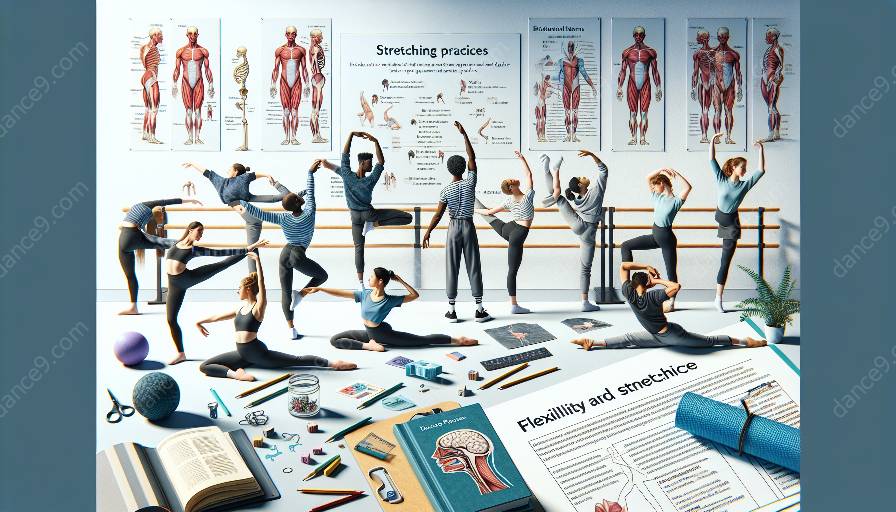Dancers require a unique combination of physical and mental conditioning to perform at their best. Flexibility and stretching play a vital role in maintaining the overall well-being of dancers, contributing to their physical health, mental strength, and performance abilities.
The Significance of Flexibility and Stretching in Dance
As a dancer, your body is your instrument, and having a flexible and supple physique is essential for executing a wide range of movements with ease and grace. Flexibility allows dancers to achieve deeper lines, higher extensions, and greater freedom of movement, all of which are fundamental to the art of dance.
Moreover, incorporating regular stretching routines into dance practice helps prevent injuries, enhances muscle endurance, and promotes overall body alignment and balance. Improving flexibility also aids in refining technique and mastering complex choreography, enabling dancers to express themselves more dynamically and proficiently.
Physical Health Benefits
Flexibility and stretching exercises contribute to the physical well-being of dancers in various ways. Not only do they improve muscle elasticity and joint mobility, but they also reduce muscle tension and promote better circulation. Proper flexibility training can alleviate muscle soreness, prevent muscle imbalances, and enhance muscular coordination, thereby reducing the risk of common dance-related injuries such as strains and sprains.
By engaging in regular stretching practices, dancers can develop stronger and more resilient bodies, empowering them to withstand the physical demands of their rigorous training and performances. Increased flexibility also facilitates better posture and alignment, leading to improved overall physical health and a reduced likelihood of experiencing chronic pain or discomfort.
Mental Health and Emotional Well-being
In addition to its physical advantages, flexibility and stretching have profound effects on the mental and emotional health of dancers. Performing arts, especially dance, can often be emotionally demanding, requiring mental resilience and fortitude. Incorporating stretching and flexibility exercises into a dancer's routine can serve as a form of active meditation, promoting relaxation and stress relief while enhancing mindfulness and focus.
Regular stretching promotes the release of endorphins, also known as 'feel-good' hormones, which can elevate a dancer's mood and contribute to a positive mindset. Furthermore, the introspective nature of stretching provides an opportunity for emotional self-awareness and reflection, allowing dancers to better connect with their bodies and emotions, thereby fostering a harmonious balance between physical and mental well-being.
Effective Techniques and Routines
For dancers seeking to enhance their flexibility and optimize their stretching routines, several effective techniques and exercises can be integrated into their practice regimen.
Dynamic Stretching
Dynamic stretching involves active movements that mimic the actions and range of motion specific to dance, such as leg swings, arm circles, and torso twists. Incorporating dynamic stretching as part of the warm-up routine can help prepare the body for dance-specific movements and gradually increase flexibility and mobility.
Static Stretching
Static stretching involves holding a specific position to elongate and relax the muscles. It is best performed after a dance session or as a separate flexibility-focused session. Targeting key muscle groups such as the hamstrings, quadriceps, calves, and hip flexors through static stretches can significantly improve a dancer's overall flexibility and alleviate muscle tightness.
Proprioceptive Neuromuscular Facilitation (PNF)
PNF stretching techniques involve a combination of stretching and muscle contraction, facilitating increased flexibility and muscle relaxation. Partner-assisted PNF stretching can be beneficial for dancers, enabling them to achieve deeper and more effective muscle stretches while maintaining control and preventing injury.
Yoga and Pilates
Integrating yoga and Pilates into a dancer's cross-training routine offers a holistic approach to improving flexibility, strength, and body awareness. Both disciplines emphasize controlled breathing, mindfulness, and total-body conditioning, making them valuable complements to a dancer's flexibility and stretching practices.
Balancing Strength and Flexibility
While focusing on flexibility is essential for dancers, it is equally important to build and maintain muscular strength to support and stabilize their range of motion. Incorporating strength training exercises, particularly targeting the core, glutes, and stabilizing muscles, can enhance a dancer's ability to execute dynamic and controlled movements without compromising flexibility.
Conclusion
Flexibility and stretching are integral components of a dancer's physical and mental well-being, playing a pivotal role in their overall health, performance capabilities, and emotional resilience within the realm of performing arts. By incorporating effective flexibility techniques and routines, dancers can optimize their flexibility, prevent injuries, and foster a holistic approach to their physical and mental development, ultimately enhancing their artistry and longevity in the captivating world of dance.


































